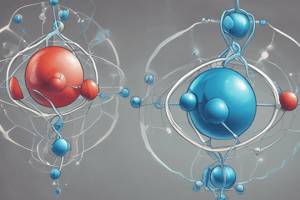Podcast
Questions and Answers
Which type of bond involves the sharing of electrons between two nonmetals?
Which type of bond involves the sharing of electrons between two nonmetals?
What occurs to potential energy when a covalent bond forms between two atoms?
What occurs to potential energy when a covalent bond forms between two atoms?
Which of the following correctly describes bond length and bond energy?
Which of the following correctly describes bond length and bond energy?
Which statement accurately compares ionic and covalent bonds?
Which statement accurately compares ionic and covalent bonds?
Signup and view all the answers
What is the smallest unit of a molecular compound?
What is the smallest unit of a molecular compound?
Signup and view all the answers
What is the result of sodium donating an electron to chlorine in terms of ion formation?
What is the result of sodium donating an electron to chlorine in terms of ion formation?
Signup and view all the answers
Which property is NOT characteristic of covalent compounds?
Which property is NOT characteristic of covalent compounds?
Signup and view all the answers
What does lattice energy indicate about an ionic compound?
What does lattice energy indicate about an ionic compound?
Signup and view all the answers
What defines a polyatomic ion?
What defines a polyatomic ion?
Signup and view all the answers
What is a key property of metals due to metallic bonding?
What is a key property of metals due to metallic bonding?
Signup and view all the answers
What primarily drives the formation of chemical bonds between atoms?
What primarily drives the formation of chemical bonds between atoms?
Signup and view all the answers
Which statement best describes a covalent bond?
Which statement best describes a covalent bond?
Signup and view all the answers
What is the relationship between electronegativity and covalent bonds?
What is the relationship between electronegativity and covalent bonds?
Signup and view all the answers
What is the role of metals and non-metals in ionic bonding?
What is the role of metals and non-metals in ionic bonding?
Signup and view all the answers
Which of the following statements about chemical formulas is true?
Which of the following statements about chemical formulas is true?
Signup and view all the answers
How many valence electrons does Selenium (Se) have?
How many valence electrons does Selenium (Se) have?
Signup and view all the answers
What is the resulting ion when Aluminum (Al) loses 3 electrons?
What is the resulting ion when Aluminum (Al) loses 3 electrons?
Signup and view all the answers
Which element shows 5 valence electrons in its Lewis Dot Structure?
Which element shows 5 valence electrons in its Lewis Dot Structure?
Signup and view all the answers
What type of bond results from the transfer of valence electrons between atoms?
What type of bond results from the transfer of valence electrons between atoms?
Signup and view all the answers
Which of the following elements is in group 14 and has 4 valence electrons?
Which of the following elements is in group 14 and has 4 valence electrons?
Signup and view all the answers
Which atom is typically not the central atom in a covalent compound?
Which atom is typically not the central atom in a covalent compound?
Signup and view all the answers
What is the maximum number of valence electrons that atoms, other than H and He, aim to have according to the octet rule?
What is the maximum number of valence electrons that atoms, other than H and He, aim to have according to the octet rule?
Signup and view all the answers
In the molecule $NF_3$, how many bonds are formed between the nitrogen and fluorine atoms?
In the molecule $NF_3$, how many bonds are formed between the nitrogen and fluorine atoms?
Signup and view all the answers
How many total electrons are shared in a double bond?
How many total electrons are shared in a double bond?
Signup and view all the answers
What is formed when two unequal energy orbitals combine?
What is formed when two unequal energy orbitals combine?
Signup and view all the answers
What is the molecular geometry of the phosphate ion (PO₄³⁻)?
What is the molecular geometry of the phosphate ion (PO₄³⁻)?
Signup and view all the answers
Which polyatomic ion has a trigonal pyramidal geometry?
Which polyatomic ion has a trigonal pyramidal geometry?
Signup and view all the answers
What is the Lewis structure of the ammonium ion (NH₄⁺)?
What is the Lewis structure of the ammonium ion (NH₄⁺)?
Signup and view all the answers
What type of geometry is associated with the chlorite ion (ClO₂⁻)?
What type of geometry is associated with the chlorite ion (ClO₂⁻)?
Signup and view all the answers
Which of the following correctly describes the geometry of methane (CH₄)?
Which of the following correctly describes the geometry of methane (CH₄)?
Signup and view all the answers
Which molecular geometry has two atoms bonded to the central atom and no lone pairs of electrons?
Which molecular geometry has two atoms bonded to the central atom and no lone pairs of electrons?
Signup and view all the answers
What type of molecular shape corresponds with three bonded atoms and no lone pairs on the central atom?
What type of molecular shape corresponds with three bonded atoms and no lone pairs on the central atom?
Signup and view all the answers
In VSEPR theory, which arrangement is expected for a molecular geometry with two bonded atoms and one lone pair?
In VSEPR theory, which arrangement is expected for a molecular geometry with two bonded atoms and one lone pair?
Signup and view all the answers
What determines whether a molecule is polar or non-polar?
What determines whether a molecule is polar or non-polar?
Signup and view all the answers
Which of the following molecular geometries involves four atoms bonded to the central atom with no lone pairs?
Which of the following molecular geometries involves four atoms bonded to the central atom with no lone pairs?
Signup and view all the answers
Which statement about polar molecules is correct?
Which statement about polar molecules is correct?
Signup and view all the answers
For a molecular shape with three atoms bonded and one lone pair, which shape is represented?
For a molecular shape with three atoms bonded and one lone pair, which shape is represented?
Signup and view all the answers
What indicates a non-polar molecule when evaluating its elements?
What indicates a non-polar molecule when evaluating its elements?
Signup and view all the answers
Which type of intermolecular force specifically involves the attraction between polar molecules?
Which type of intermolecular force specifically involves the attraction between polar molecules?
Signup and view all the answers
What type of intermolecular force occurs when a polar molecule induces a dipole in a non-polar molecule?
What type of intermolecular force occurs when a polar molecule induces a dipole in a non-polar molecule?
Signup and view all the answers
What does resonance imply about certain molecular structures?
What does resonance imply about certain molecular structures?
Signup and view all the answers
In a polar molecule's dipole representation, what does the direction of the arrow indicate?
In a polar molecule's dipole representation, what does the direction of the arrow indicate?
Signup and view all the answers
Which type of intermolecular force is present in noble gases and non-polar molecules?
Which type of intermolecular force is present in noble gases and non-polar molecules?
Signup and view all the answers
Which example best illustrates a dipole-dipole interaction?
Which example best illustrates a dipole-dipole interaction?
Signup and view all the answers
Which of the following statements is true about dipole-induced dipole forces?
Which of the following statements is true about dipole-induced dipole forces?
Signup and view all the answers




